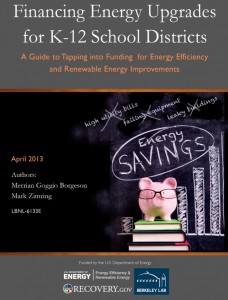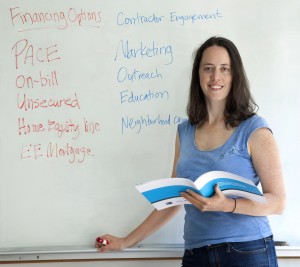APRIL 02, 2013
510-486-4210 a_chen@lbl.gov
9
News Release
Energy costs K-12 schools in the U.S. $6 billion dollars annually. Spending less money on energy costs would leave more for funding-constrained school districts to spend on educating their students, according to researchers at the U.S. Department of Energy’s Lawrence Berkeley National Laboratory (Berkeley Lab).Public and private financing is available, but navigating the complicated landscape of grants, bonds, leasing arrangements and other types of financing can be difficult for school administrators and facilities managers, who are not necessarily experts in financing for energy efficiency and renewables.

Researchers Merrian Borgeson and Mark Zimring, in Berkeley Lab’s Environmental Energy Technologies Division (EETD), have released a guide on planning and financing comprehensive energy upgrades that involve multiple measures and are targeted toward achieving significant and persistent energy savings.
Written for school district administrators
The guide is written explicitly for school administrators, facilities managers, and others in K-12 education management. It covers different options for public and private financing approaches, and contains numerous case studies of school district projects. The authors provide explanations of financial terms and mechanisms.
“The money spent on energy for schools is their second-highest operating expenditure after personnel costs—more money than is spent on textbooks and computers combined,” says Borgeson. “Comprehensive energy efficiency upgrades for schools bring them a lot of benefits—the biggest might be that lower energy bills allow them to spend more money on hiring teachers and buying supplies.”
Another significant benefit is that energy efficiency upgrades result in modernized infrastructure and lower maintenance costs—for example, through improved heating and cooling systems, energy-efficient windows and roofs, and better ventilation.
These energy upgrades also improve the comfort, health and safety of school buildings. Fixing the hot and cold spots, leaky walls and roofs, and broken windows not only reduces energy costs, it improves the indoor environmental quality of the building, and enhances the ability of students to learn and teachers to teach. Chosen carefully, energy-efficient equipment, for example, can be quieter, and do a better job at removing indoor pollutants that can affect human cognitive ability. Removing mold and toxic materials provides a safer learning environment.
Case studies provide guidance to overcoming obstacles
Six case studies drawn from the experience of school districts around the U.S. tell the stories of how district policymakers overcame obstacles, built consensus, and chose funding mechanisms for energy efficiency upgrades that were widely accepted by their districts’ stakeholders—parents, taxpayers, political leadership.
Williamson County School District in Tennessee, for example, entered into an energy savings performance contract (ESPC) with an energy services company (ESCO) and completed a $5.7 million lease-purchase agreement to fund a range of energy-related improvements across 27 school facilities.
The lease-purchase agreement helped reduce the barrier of up-front costs of the upgrades, and re-financing a year later benefitted both the district and taxpayers. The project will pay for itself in six and a half years, and continue saving money for the district long after that time.
Douglas County School District, Nevada, used a combination of financial mechanisms to fund $10.7 million in upgrades. They tapped into federal Qualified School Construction Bonds, an American Recovery and Reinvestment Act grant, and voter-approved General Obligation bonds to fund a range of equipment and facility improvements.
“Most schools already have access to many of the financing tools they need to invest in these improvements,” says Borgeson, “We think that every school has the potential to become a high performance school, one that has an improved student learning environment, and saves energy, resources, and money. They just need to understand what the opportunities are, and tap into those opportunities.”
“Financing Energy Upgrades for K-12 School Districts,” by Merrian Borgeson and Mark Zimring, is available for free download here. The work was funded by the U.S. Department of Energy’s Office of Energy Efficiency and Renewable Energy, and the American Recovery and Reinvestment Act.
# # #
Lawrence Berkeley National Laboratory addresses the world’s most urgent scientific challenges by advancing sustainable energy, protecting human health, creating new materials, and revealing the origin and fate of the universe. Founded in 1931, Berkeley Lab’s scientific expertise has been recognized with 13 Nobel prizes. The University of California manages Berkeley Lab for the U.S. Department of Energy’s Office of Science. For more, visit www.lbl.gov.

No comments:
Post a Comment
Note: Only a member of this blog may post a comment.